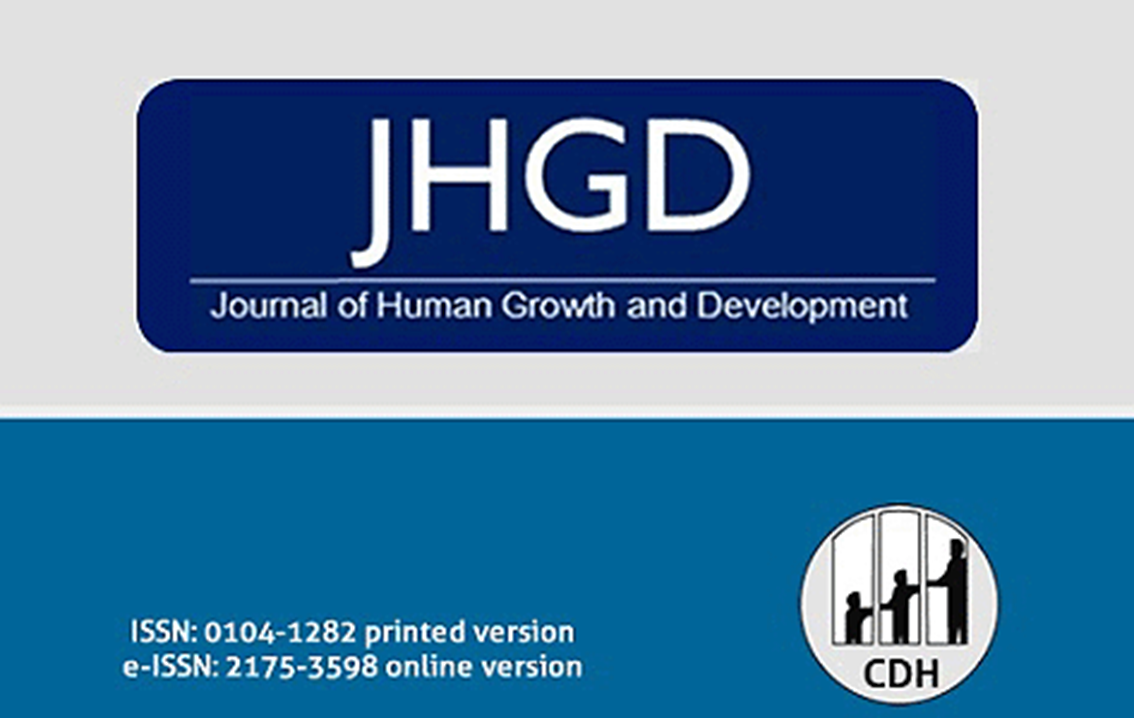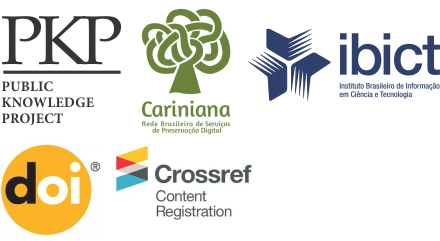Infants’ peer interaction in institutional foster care service
DOI:
https://doi.org/10.7322/jhgd.v30.9975Keywords:
Infants, Child foster, Social interaction, Peer interactionAbstract
Introduction: Based on the perspective of children’s intersubjectivity, it is understood that infants are able to interact with infants from a very early age. These interactions can offer important constitutive experiences for them.
Objective: It was investigated how interactions between infants-infants/toddlers in institutional care occur, describing: the frequency of these interactions; the emotional-communicative resources involved; partners’ responsiveness; and the environmental organization.
Methods: A qualitative, descriptive, and exploratory case study was conducted. Participants were focal baby (aged between 10 and 13 months) and their interactive peers (4 to 17 months) in institutional care. We used weekly video recordings for three months in the naturalistic context. The categories “attention orientation”, “search/maintenance of proximity”, “social exchanges”, and “responsiveness” were quantified and compared with the interaction between infant and caregiver. Interactive episodes were also thoroughly described.
Results: Cribs, strollers, gates, and grids, with few toys available, marked the organization of the physical-social space. It was observed that the infants spent most of their time in individual activities (alone); and their social behaviors were more often directed to caregivers.
The interactions between infants/toddlers were less frequent, although it was with the peers that social exchanges, joint activities, and co-regulated interactions occurred the most (with reciprocity and sharing). Peer responsiveness also involved empathic and pro-social behaviors (with experiences of interpersonal engagement), where attentional, emotional, and motivational processes operated.
Conclusion: Peers interactions between infants/toddlers in institutional care were infrequent. However, when it occurred, the children showed sensitivity and responsiveness to their peers' emotional-communicative expressions. The organization of the institutional environment proved to be a relevant constraint of peer interactions: due to the material/spatial arrangement that made contact between children difficult; and by the absence of the adult as a promoter of these interactions. Finally, we call attention to the need for further investigations about interactive indicators of infants in institutional care.
Downloads
References
2. Vasconcelos CRFE, Amorim KS, Anjos AM, Ferreira MCR. A incompletude como virtude: interação de bebês na creche. Psicol Reflex Crit. 2003;16(2):293-301. DOI: https://dx.doi.org/10.1590/S0102-79722003000200009
3. Amorim KS. Processos de significação no primeiro ano de vida. Psicol Teor Pesq. 2012;28(1):45-53.
4. Aldrich NJ, Brooks PJ, Yuksel-Sokmen O, Ragir S, Flory MJ, Lennon EM, et al. Infant twins’ social interactions with caregivers and same-age siblings. Infant Behav Dev. 2015;(41):127-41. DOI: https://doi.org/10.1016/j.infbeh.2015.08.005
5. Bradley BS, Smithson M. Groupness in preverbal infants: proof of concept. Front Psychol. 2017;(8):385. DOI: https://doi.org/10.3389/fpsyg.2017.00385
6. Pedrosa MIPC, Carvalho AMA. Aprendendo sobre eventos físicos com parceiros de idade. Psicol USP. 2009;20(3):355-73. DOI: https://doi.org/10.1590/S0103-65642009000300004
7. Lucena JMF, Pedrosa MI. Estabilidade e transformação na construção de rotinas compartilhadas no grupo de brinquedo. Psicol Reflex Crit. 2014;27(3):556-63. DOI: https://dx.doi.org/10.1590/1678-7153.201427317
8. Costa CA, Amorim KS. Abreviação em relações de bebês com seus pares de idade. Psicol Teor Pesq. 2015;31(1):15-23. DOI: http://dx.doi.org/10.1590/0102-37722015011798015023
9. Tomasello M. The cultural origins of human cognition. Cambridge: Harvard University Press, 1999.
10. Bussab VRS, Pedrosa MI, Carvalho AMA. Encontros com outro: empatia e intersubjetividade no primeiro ano de vida. Psicol USP. 2007;18(2):99-133. DOI: http://dx.doi.org/10.1590/S0103-65642007000200007
11. Liddle MJ, Bradley B, McGrath A. Baby empathy: Infant distress and peer prosocial behaviour. Infant Ment Health J. 2015;36(4):446-458. DOI: https://doi.org/10.1002/imhj.21519
12. Moura GG, Amorim KS. Infants’ interactions in foster and institutional care: two exploratory studies. Psicol Estud. 2018;(23):1-18. DOI: https://doi.org/10.4025/psicolestud.v23.e40287
13. Carvalho C, Moura GG, Amorim KS. Práticas de cuidado de crianças com bebês em instituição de acolhimento. Psicol Pesq. 2019;13(3):48-72. DOI: https://doi.org/10.34019/1982-1247.2019.v13.25781
14. Zangirolami-Raimundo J, Echeimberg JO, Leone C. Research methodology topics: cross-sectional studies. J Hum Growth Dev. 2018;28(3):356-360. DOI: http://dx.doi.org/10.7322/jhgd.152198
15. Rossetti-Ferreira MC, Amorim KS, Silva APS. Rede de significações: alguns conceitos básicos. In: Rossetti-Ferreira MC, Amorim KS, Silva APS, Carvalho AMA. Rede de significações e o estudo do desenvolvimento humano. São Paulo: Artmed, 2004; p. 24-41.
16. Amorim, KS, Dentz, MV, Costa, NMS. Videogravação nas ciências humanas: o dilema entre potencial da imagem e direito de preservação da identidade. In: Leme MIS, Cagnin S, Leite SAS. Pesquisa aplicada em psicologia: implicações éticas. Campinas: Mercado das Letras, 2018; p.13-48.
17. Carvalho AMA, Império-Hamburger A, Pedrosa, MIP. Interaction, regulation and correlation: conceptual discussion and empirical examples in the context construction of psychological process in interpersonal communication. Stanford: Abblex, 1998.
18. Carvalho AMA, Rubiano MRB. Vínculo e compartilhamento na brincadeira de crianças. In: Rossetti-Ferreira MC, Amorim KS, Silva APS, Carvalho AMA. Rede de significações e o estudo do desenvolvimento humano. São Paulo: Artmed, 2004; p. 208-33.
19. Brasil. Conselho Nacional de Saúde. Resolução nº 510, de 24 de maio de 2016. Dispõe sobre as normas aplicáveis às pesquisas em Ciências Humanas e Sociais e complementa a Resolução 466 de 2012. Diário Oficial União. 2016;(98).
20. Valsiner J. Ontogeny of co-construction of culture within socially organized environment settings. In: Valsiner J. Child development within culturally structured environments – Social co-construction and environmental guidance in development. Norwood: Ablex Publishing Corporation, 1988; p. 283-97.
21. Golin G, Benetti SPC, Donelli TMS. Um estudo sobre o acolhimento precoce inspirado no método bick. Psicol Estud. 2011;16(4):561-9. DOI: http://dx.doi.org/10.1590/S1413-73722011000400007
22. Groark CJ, McCall RB. Implementing changes in institutions to improve Young children’s development. Infant Ment Health J. 2011;32(5):209-25. DOI: https://doi.org/10.1002/imhj.20310
23. Jacobsen H, Vang KA, Lindahl KM, Larsen TW, Smith L, Moe V. Quality of social interaction in foster dyads at child age 2 and 3 years. Child Psychiatry Hum Dev. 2019;50(1):121-31. DOI: https://doi.org/10.1007/s10578-018-0823-7
24. Alvarenga P, Malhado SCB, Lins TCS. O impacto da responsividade materna aos 8 meses da criança sobre as práticas de socialização maternas aos 18 meses. Estud Psicol. 2014;19(4):305-14. DOI: http://dx.doi.org/10.1590/S1413-294X2014000400008
25. Trevarthen C. Form, significance and psychological potential of hand gestures of infants. In: Nespoulous JL, Perron P, Lecours AR. The biological foundation. Hillsdale: Erlbaum, 1986; p. 149-62.
26. Bussab VSR. O desenvolvimento de comportamentos pró-sociais na criança: considerações sobre a natureza dos fatores e dos processos envolvidos. Temas Psicol. 1997;5(3):19-26.
27. Amorim KS, Rossetti-Ferreira MC. Corporeidade, significação e o primeiro ano de vida. Arq Bras Psicol. 2008;60(1):67-81.
28. Costa NMS, Amorim KS. A co-construção do fluxo locomotor em processos interativos bebê-bebê. Psicol Pesq. 2018;12(3):1-11. DOI: http://dx.doi.org/10.24879/2018001200300489
29. Viana KMP, Pedrosa MI. Brincadeiras coordenadas cooperativas e o compartilhamento de intenções em crianças. Psicol Reflex Crit. 2014;27(3):564-72. DOI: http://dx.doi.org/10.1590/1678-7153.201427318
30. Dentz M, Amorim KS. Expressões emocionais entre bebês na creche: revisão sistemática da literatura. Psicol Rev. 2019;25(1):133-54. DOI: http://dx.doi.org/10.5752/P.1678-9563.2019v25n1p133-154
31. Campos-de-Carvalho M. Psicologia ambiental e do desenvolvimento: o espaço em instituições infantis. In: Guzzo RS, Pinheiro JQ, Günther H. Psicologia ambiental: entendendo as relações do homem com seu ambiente. 3 ed. Campinas: Alínea, 2015; p. 181-96.
32. Oliveira RC. A história começa a ser revelada: panorama atual do abrigamento no Brasil. In: Baptista MV. Abrigo: comunidade de acolhida e sócio-educação. São Paulo: Instituto Camargo Correa, 2006; p.35-48.
33. McCall RB, Groark CJ, Rygaard NP. Global research, practice, and policy issues on the care of infants and young children at risk: the articles in context. Infant Ment Health J. 2014;35(3):87-93. DOI: https://doi.org/10.1002/imhj.21441
34. Wendt B, Tavares MDF, Penno DK, Dell'Aglio DD. Imagens sociais atribuídas às instituições de acolhimento. Rev SPAGESP. 2018;19(1):35-48.







